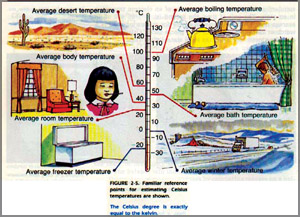 How
things are measured How
things are measured
When
we measure a weight, length or temperature, we use some kind of unit for
easy reference. However, in ancient times, people used the size of their
palm or foot to measure a length, but it greatly depended on each
person's body size.
Therefore, the whole world needed a standard measurement that could
be used everywhere. In order to fulfil this need, a group of scientists
formed a system of units known as the 'International System of Units' or
SI units.
This is a modern form of the metric system. It is the world's most
widely used system of units, both in everyday commerce and science.
 Formation
of SI units Formation
of SI units
A group of scientists (among them, Antoine-Laurent Lavoisier, who is
known as the 'father of modern chemistry') which had been commissioned
by King Louis XVI of France to create a unified and rational system of
measures conceived the metric system.
The metric system has a long history and has seen a number of
changes. Its use has spread around the world, replacing many traditional
measurement systems.
It was recognized that additional steps were needed to promote a
worldwide measurement system.
As a result, the ninth General Conference on Weights and Measures (CGPM),
held in 1948, asked the International Committee for Weights and Measures
(CIPM) to conduct an international study of the measurement needs of the
scientific, technical and educational communities.
Based on the findings of this study, the 10th CGPM held in 1954
decided that an international system should be derived from six base
units to provide for the measurement of temperature and optical
radiation in addition to mechanical and electromagnetic quantities.
The six base units recommended were the metre, kilogram, second,
ampere, degree Kelvin (later renamed the kelvin), and the candela. In
1960, the 11th CGPM named the system the International System of Units,
abbreviated SI from the French name Le Systeme international d'unites.
The seventh base unit, the mole, was added in 1971 by the 14th CGPM.
The SI units
The units of SI can be divided into two sub-sets. There are seven
base units. Each of these base units is nominally (in numbers) and
dimensionally independent. From these seven base units, several other
units are derived.
 SIS
writing style SIS
writing style
Symbols do not have an appended (attached) period or full stop (.)
unless at the end of a sentence. Symbols are written in upright Roman
type (m for metres, l for litres), to differentiate from the italic type
used for mathematical variables (m for mass, l for length).
Symbols for units are written in lower case, except for symbols
derived from the name of a person. For example, the unit of pressure is
named after Blaise Pascal, so its symbol is written 'Pa' whereas the
unit itself is written "pascal".
The one exception is the litre, whose original symbol 'l' is similar
to the numeral '1' or the uppercase letter 'i' (depending on the
typeface used), at least in many English-speaking countries. The SI rule
for pluralising units is that symbols of units are not pluralised, for
example '25 kg' (not '25 kgs').
A space separates the number and the symbol, e.g. '2.21 kg', '7.3x102
m2', '22 K'. Exceptions are the symbols for plane angular degrees,
minutes and seconds, which are placed immediately after the number with
no intervening space.
Spaces may be used as a thousands separator (1 000 000) in contrast
to commas or periods (1,000,000 or 1.000.000) in order to reduce
confusion resulting from the variation between these forms in different
countries.
In print, the space used for this purpose is typically narrower than
that between words. Symbols for derived units formed from multiple units
by multiplication are joined with a space or centre dot (.), e.g. 'N m'
or 'N.m'.
Symbols formed by the division of two units are joined with a solidus
(/), or given as a negative exponent. For example, the 'metre per
second' can be written 'm/s', 'ms-1', 'm.s-1'. A solidus should not be
used if the result is ambiguous (uncertain), i.e. 'kg.m-1.s-2' is
preferable to 'kg/m.s2'.
When writing dimensionless quantities, the terms 'ppb' (parts per
billion) and 'ppt' (parts per trillion) are recognised as
language-dependent terms since the value of billion and trillion can
vary from language to language. SI therefore recommends avoiding these
terms. However, no alternative is suggested by BIPM.
Compiled by Janani Amarasekara |
